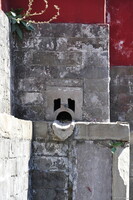Miaoying Temple
Arniko

Download1A2-CH-B-MM-G08_cp.jpg (590.0Kb)
Alternate file
Alternative Titles
Miaoying si
妙应寺
Date
1271-1644Description
Stone scupper in wall surrounding the White Dagoba (Bai ta); The Miaoying si (Temple of the Miraculous Response) is one of the Buddhist temples and lamaseries in Beijing which predate the Yuan city; the original buildings dated to the Liao. Stupa-type pagodas flourished between the 13th and 18th centuries, when the Chinese were close to or keen to placate their Lamaist Buddhist neighbors in Mongolia and Tibet. As a result, the stupas are closer to Tibetan forms: giant, white, tapering bottle shapes topped with bronze flattened umbrella shapes. The prototype and most notable is the Bai ta (White Pagoda or White Dagoba; 1271, Yuan Dynasty), which dominates the temple complex. Built by Arniko, a Nepalese artist and architect employed by Kublai Khan, it took ten years to complete. The rest of the remaining buildings date from the Ming Dynasty (the area as rebuilt was smaller, 3.2 acres total). The White Stupa was spared during the Cultural Revolution, but the temple suffered severe damage in the 1976 Tangshan Earthquake. Source: Grove Art Online; http://www.oxfordartonline.com/ (accessed 5/13/2014)
Type of Work
temple; pagoda (building); monasterySubject
architecture, deities, Buddhism and art--China, tantric Buddhism, Yüan, Ming
Rights
Rights Statement
Licensed for educational and research use by the MIT community only